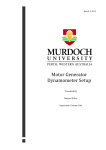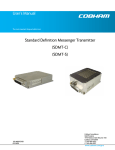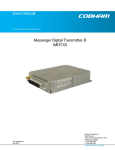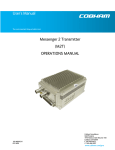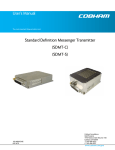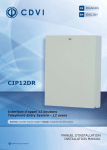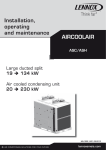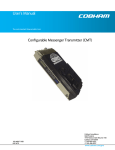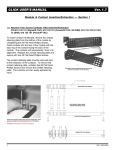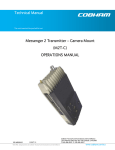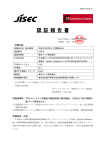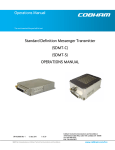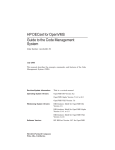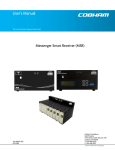Download User`s Manual
Transcript
User’s Manual The most important thing we build is trust. Messenger High-Power Transmitter (MHPT) 100-M0075X1 06/17/09 Cobham Surveillance GMS Products 1916 Palomar Oaks Way Ste 100 Carlsbad, CA 92008 T: 760-496-0055 F: 760-496-0057 www.cobham.com/gms Table of Contents 1.0 ACRONYMS................................................................................................................................................................ 3 2.0 THEORY OF OPERATION.................................................................................................................................. 4 3.0 HARDWARE OVERVIEW ................................................................................................................................... 5 3.1 MHPT Connectors.................................................................................................................................................6 3.1.1 RF Output.............................................................................................................................................................6 3.1.2 Data/Control.......................................................................................................................................................6 3.1.3 Audio .....................................................................................................................................................................6 3.1.4 DC in ......................................................................................................................................................................6 3.1.5 Y/CVBS ..................................................................................................................................................................6 3.1.6 C/Pr .........................................................................................................................................................................7 3.1.7 Pb.............................................................................................................................................................................7 3.1.8 SDI (Optional) ....................................................................................................................................................7 4.0 SOFTWARE OVERVIEW..................................................................................................................................... 7 4.1 System Requirements .........................................................................................................................................8 4.2 Installation ...............................................................................................................................................................8 4.3 MHPT Configurator Functions ........................................................................................................................8 4.3.1 Function Buttons...........................................................................................................................................10 4.3.2 Field Definitions.............................................................................................................................................10 4.3.3 Pull-Down Menu Definitions ....................................................................................................................12 4.3.3.1 File................................................................................................................................................................12 4.3.3.2 Configuration...........................................................................................................................................12 4.3.3.3 Help..............................................................................................................................................................15 5.0 GETTING STARTED........................................................................................................................................... 18 5.1 Initial Checkout...................................................................................................................................................18 6.0 SPECIFICATIONS .............................................................................................................................................. 20 6.1 Video Encoding...................................................................................................................................................20 6.2 Audio Encoding...................................................................................................................................................20 6.3 Transport Stream ...............................................................................................................................................20 6.4 RS-232 Interfaces/RCU/USB .........................................................................................................................20 6.5 COFDM RF Output.............................................................................................................................................20 6.6 Modulation ...........................................................................................................................................................21 6.7 Power.......................................................................................................................................................................21 6.8 Physical Dimensions (without mating connectors).............................................................................21 6.9 Environmental .....................................................................................................................................................21 6.10 MHPT Special Features....................................................................................................................................21 7.0 THE D/C (DOWN CONVERTER)/IF FREQUENCIES EXPLAINED ......................................... 22 7.1 IF Frequencies .....................................................................................................................................................22 7.2 Local and Remote Power ................................................................................................................................22 8.0 CABLE LOSSES...................................................................................................................................................... 24 8.1 Coax Cable............................................................................................................................................................24 100-M0075X1 2 of 27 www.cobham.com/gms List of Tables Table 1 - MHPT Field Definitions....................................................................................................................................10 Table 2 - DB-9 Connector Pin Out for the D/C .........................................................................................................23 List of Figures Figure 1 – MHPT Connectors..............................................................................................................................................6 Figure 2 – MHPT Configurator Main Screen.................................................................................................................9 Figure 3 - MHPT Configurator Main Screen..................................................................................................................9 Figure 4A– Scrambling Mode setup..............................................................................................................................12 Figure 4B – Scrambling Mode setup .............................................................................................................................13 Figure 5- Scrambling Key Setup.....................................................................................................................................13 Figure 6 – Others Menu Screen.......................................................................................................................................15 Figure 7 - Channel Rate Guide .........................................................................................................................................16 Figure 8 - FW Version..........................................................................................................................................................16 Figure 9 - About .....................................................................................................................................................................17 Figure 10 - Basic SDML Setup..........................................................................................................................................18 Figure 11- BDC Connectors ..............................................................................................................................................23 List of Appendices Appendix A – CABLE, EXTERNAL, P8, MHPT..............................................................................................................25 Appendix B – CABLE, EXTERNAL, P7, MHPT..............................................................................................................26 Appendix C – CABLE, EXTERNAL, P6, MHPT..............................................................................................................27 100-M0075X1 3 of 27 www.cobham.com/gms 1.0 Acronyms This section lists and describes the various acronyms used in this document. Name 16 QAM 64 QAM A/V AES ABS ASI COFDM CVBS/Y C D/C DDR DVB-T FEC GUI I/O Kbaud Kbps Mbps MDL MDR MDT MER MPEG MSR NTSC PAL QPSK RF RX SDI SDML SDMT S/N THD TX VDC 100-M0075X1 Meaning 16-state Quadrature Amplitude Modulation 64-state Quadrature Amplitude Modulation Audio/Video Advanced Encryption System (32 bit) Messenger Basic Scrambling (8 bit) Asynchronous Serial Interface Coded Orthogonal Frequency Division Multiplexing Composite video/Luminance with S-video Chroma video Down-Converter Digital Diversity Receiver Digital Video Broadcasting-Terrestrial Forward Error Correction Graphical User Interface Input/ Output Kilobaud per second Kilobits per second Megabits per second Messenger Digital Link Messenger Digital Receiver Messenger Digital Transmitter Modulation Error Rate Moving Picture Experts Group Messenger Smart Receiver National Television System Committee Phase Alternation Line Quadrature Phase Shift Keying Radio Frequency Receiver Serial Digital Interface Standard Definition Messenger Link Standard Definition Messenger Transmitter Signal-to-Noise Ratio Total Harmonic Distortion Transmitter Volts (Direct Current) 4 of 27 www.cobham.com/gms 2.0 Theory of Operation The MHPT accepts either a SDI, ASI, composite, component or a S-video signal, analog stereo audio inputs (Mic or Line level), and a RS232 data input. The video is compressed according to MPEG-2 specifications. However, unlike other MPEG-2 systems, all of the high-frequency video signal components are preserved. The audio is converted to a 728kb/s stream. The audio, video and data packet streams are multiplexed with basic service data to indicate the service name. The stream can be scrambled with either a simple fixed-key scrambling or AES scrambling system to provide protection in sensitive applications. The video and audio are compressed (ASI data streams are passed through bypassing the MPEG encoder) according to MPEG specifications (Video MPEG-2 and Audio MPEG-1 layer II). The MPEG-2 supports 4:2:0 Chroma sampling, MP@ML and SP@ML profiles and maintains the original signal’s video fidelity. The audio and video program element streams are multiplexed with basic service data to indicate the service name into a DVB compliant Transport Stream (TS). The TS stream is then sent through a DVB-T compliant FEC encoder and COFDM modulator. This is output from the FPGA based modulator core as digital I/Q signals that are converted to Analog I/Q signals and applied to an I/Q Modulator. The LO that provides the carrier to this I/Q modulator comes from a low phase-noise programmable synthesizer. The modulated RF output of the I/Q modulator IC is sent through amplifier chain and ultimately output to the outside world. Programmable attenuators in the RF processing chain provide signal leveling. One of the biggest problems encountered in the transition from an analog to a digital A/V Platform has been the inherent digital coding delays that in some digital systems are 400ms or more. The MHPT/MSR combination employs a specially designed ‘low delay’ coding technology, which provides an end-to-end latency of approx. 198ms without the introduction of any further MPEG encoding artifacts. This ensures that the picture you see is what is happening now - crucial for applications such as sports coverage, surveillance, and law enforcement, where personnel are reacting to real-time events The transmitter is microprocessor controlled. Normally the transmitter is controlled either through an RS-232 or USB interface via either GMS’ MS Windows control SW or a simple command line interface. 100-M0075X1 5 of 27 www.cobham.com/gms 3.0 Hardware Overview Figure 1 shows the hardware configuration of the MHPT: Y/CVBS C/Pr Pb SDI in (Optional) RF Output Data/Control Audio DC in Figure 1 – MHPT Connectors 3.1 MHPT Connectors 3.1.1 RF Output The MHPT uses a female ‘N” type bulkhead connector for its ‘RF Output’ port. 3.1.2 Note: Transmitters should not be powered on without a load. Doing so could cause damage to the output PA. A proper heat sink is also required. Data/Control The Data/Control port provides a two-port interface of RS-232 signals and a USB port. The RS232 Data port is designed for user data input. The RS232 Control port and/or USB are used for control and monitoring of the MHPT unit using GMS’ MS Windows-based Configurator software program. GMS cable (780-C0217) is used to connect to the Data/Control connector. See drawing 100-C0217 for RS232 and USB connections (Appendix C). 3.1.3 Audio Two channels (Audio1, Audio2) of balanced audio input are provided. GMS cable 780C0218 is used to connect to the Audio connector. See drawing 100-C0218 for connections (Appendix B). 3.1.4 DC in The MHPT accepts 12 or 24 VDC input power (depending on configuration) 100-M0075X1 6 of 27 www.cobham.com/gms GMS cable (780-C0219) is used to connect to the DC in connector. See drawing 100C0219 for power connections (Appendix A). 3.1.5 Y/CVBS This connector is a dual use input connector; a) Composite Video or b) Luminance when used with Component video. 3.1.6 C/Pr This connector is a dual use input connector; a) Chroma when used with S-Video or b) Pr, the red component minus the luminance information when used with Component video. 3.1.7 Pb This is the blue component minus the luminance information used with Component video. 3.1.8 SDI (Optional) This input is used for SDI (Serial Data Interface) input (This option can be purchased separately) 100-M0075X1 7 of 27 www.cobham.com/gms 4.0 Software Overview Configuration, control and monitoring of the MHPT unit is accomplished by using GMS’ optional (sold separately) MS Windows-based MHPT Configurator software program. This Graphical User Interface (GUI) program provides the end user with a straightforward way to interface with the MHPT. During normal operation, once a HP-MDL link is established, the MHPT Configurator GUI does not need to be active and can be disconnected from the MHPT. 4.1 System Requirements The MHPT Configurator program has been developed and tested on Windows 2000, Windows XP and Windows NT. Although the MHPT Configurator program may work properly on other operating systems, only the Windows 2000, Windows XP and Windows NT environments have been used at GMS and no support or assistance can be provided concerning other operating systems. 4.2 Installation The following instructions outline the installation process for the MHPT Configurator program: 1. Insert provided CD-ROM into computer. 2. Click on ‘setup.exe’ file. This will launch the GMS_HMT Configurator Setup program and several initial setup files will begin to be copied onto the computer. 3. After the initial setup files are copied over, the GMS_MHPT Configurator Setup program will prompt the user to close any applications that are running. Once all other programs are exited, click on the ‘OK’ button. 4. The GMS_MHPT Setup program will prompt the user to click on the ‘computer icon’ button to begin installation. If desired, the user can change the destination directory from the default. Click on the ‘computer icon’ button. 5. The GMS_MHPT Setup program will then prompt the user to ‘Choose Program Group’. If desired, the user can change the program group from the default. Click on the ‘Continue’ button. 6. After installing the MHPT Configurator program, it will display a window indicating that setup was completed successfully. Click ‘OK’. 4.3 MHPT Configurator Functions The MHPT Configurator program provides the user access to many different configuration, control and monitoring options. When the MHPT Configurator program is launched, the screen shown in Figure 2 is displayed. The user should first select the serial port their computer is connected to via the Serial Port Selector and Status region. If the selected serial port is valid, the gray-colored status box will show ‘Ready. To configure a SDMT, select the ‘SDMT’ box in the Device Selector region. Once the ‘SDMT’ box is selected, the screen shown in Figure 3 is displayed. The MHPT Configurator program contains function buttons and all the configurable settings available on a MHPT. The following sections explain, in detail, the various options. 100-M0075X1 8 of 27 www.cobham.com/gms Figure 2 – MHPT Configurator Main Screen Figure 3 - MHPT Configurator Main Screen 4.3.1 Function Buttons • “Reset Tx Button: Clicking on this button re-boots the transmitter to an initial known state. Note that it takes approximately 20 seconds to fully initialize the transmitter. 100-M0075X1 9 of 27 www.cobham.com/gms • “Store All Setup Pages” Button: Clicking on this button will store all setup pages, even if they are not shown. • “Enable All” Button: Clicking on this button enables all the check boxes on the screen. This operation is done to prepare all the fields to be written to (or read from). Alternatively, the end user can individually select a given field by using the mouse and clicking its corresponding check box • “Disable All” Button: Clicking on this button disables all the check boxes on the screen. This operation is done to inhibit all the fields to be written to (or read from). Alternatively, the end user can individually deselect a given field by using the mouse and clicking its corresponding check box. • “Query” Button: Clicking on this button performs a read operation on all the fields that have their check box enabled. Once clicked, all the selected fields will be read back reflecting their current configuration. • “Update” Button: Clicking on this button performs a write operation on all the fields that have their check box enabled. Once clicked, all the selected fields will be written to with the value denoted in their respective field. • “CLR” Button: Clicking on this button clears out all fields on the screen, regardless of whether the fields’ check boxes are selected or not. This button proves useful when the end user wants to verify that a write operation has been correctly performed. An example scenario would be to 1) enable all fields, 2) change desired field(s), 3) perform a ‘Update’ (write) operation, 4) perform a ‘CLR’ operation and 5) perform a ‘Query’ operation. As a result of the ‘Query’ operation, the fields on the screen should all update to those values that were written during the ‘Update’ operation. 4.3.2 Field Definitions There are several different fields that can be configured by the SDMT Configurator. The fields located in the main screen of Figure 3 and their associated values are defined in Table 1 below. Also noted in the table is whether the field is read, write-able or both Table 1 - MHPT Field Definitions Field Unit Name Unit Number 100-M0075X1 R/W R/W R/W RF Freq (MHz) R/W Modulation R/W Description Allows the user to assign a unique unit name to the MHPT. Allows the user to assign a unique unit number to the MHPT RF output frequency. Desired frequency is entered in MHz (i.e., 1.296GHz would be entered as 1296). Default frequency step size is 500KHz. For S2 band it’s 250KHz. Modulation mode. Desired modulation mode is 10 of 27 www.cobham.com/gms Field Mode Description selected from the following values: C-OFDM (default) Off (shuts off modulation) or I/Q CAL ON (puts unit in calibration mode). COFDM COFDM transmit bandwidth. Desired bandwidth is R/W selected from the following values: 6, 7 or 8 MHz. Bandwidth COFDM Mode COFDM modulation type. Desired COFDM modulation type is selected from the following R/W values: QPSK, 16 QAM or 64 QAM (only in ASI mode) Modulation guard interval size. Desired modulation Mod Guard guard interval size is selected from the following Interval R/W values: 1/32, 1/16, 1/8 or ¼. (not all values available to MHPT and MHPT-S units, configuration type dependent). Modulation FEC (Forward Error Correction) rate. Modulation Desired modulation FEC rate is selected from the FEC R/W following values: ½, 2/3, ¾, 5/6, 7/8 (not all values available to MHPT and MHPT-S units, configuration type dependent.). Channel rate is displayed based on parameters Channel Rate selected such as COFDM mode, FEC and Guard (Mbps) R Interval. Channel rate is limited to 15Mbps when Analog Video input or SDI input is selected. R/W Choice between Analog video, SDI, or ASI Input Mode Video input format. Desired video input format is Video Input selected from the following values: PAL, NTSC w/ Pedestal, NTSC, S-video PAL, S-video NTSC, and R/W Component Video. Some of these choices may or may not be shown in the pull down box depending on which user profile has been loaded. Analog video lock status. This read-only field Video Locked indicates that the MHPT has line-locked onto the Status R analog video input signal [not applicable when the “Input Mode” is set to either SDI or ASI] Analog audio encoder enable. Desired mode of Audio Enable * R/W operation of the audio encoder is selected from the following values: Off or On. Audio Mute * R/W Choice between mute or un-mute audio stream Audio Level * R/W Choice between mic or line level audio Audio Gain * R/W Adjustable gain between 0- 100 * Not applicable for embedded audio applications. 4.3.3 Pull-Down Menu Definitions There are several different pull-down menus that are included in the MHPT Configurator program. Each of these pull-down menus contains further user-configurable options or commands. The following sections describe these menus in detail. 100-M0075X1 R/W 11 of 27 www.cobham.com/gms 4.3.3.1 File This pull-down menu offers to exit the MHPT Configurator program. Alternatively the ‘X’ box in the upper right hand corner of the window can be used to exit the program. The “Store All Setup Pages” button on the main menu will save all parameters. 4.3.3.2 Configuration This pull-down menu contains several different configuration options. These are outlined below: Special Setup o Scrambling Mode (Option,this menu not available if option is not purchased) – This pull down menu displays the following (see Figure 4A & 4B): OFF- Scrambling (Encryption) turned off (disabled). AES,Never Store the key in the TX – Scrambling is turned on (Enabled). When scrambling is turned on, a key code (a series of 32 Hex characters) must be entered. Entering the key code is discussed in the following section (Scrambling Key). In this mode the key code is not stored in the transmitters memory. When power is removed the key code will be lost and must be re-entered when power is re-applied. The same key code must be entered in the DDPC of the MSR. See DDPC manual 100-M0070. AES, Store the key in the Tx – Scrambling is turned on (Enabled). In this mode the key is stored in the transmitters memory. When power is removed the key code will not be lost. Query – Clicking this button performs a read operation which will read back the current scrambling mode configuration. Apply – Clicking this button will perform a write operation of the selected mode. Exit - Exit the scrambling mode. Figure 4A– Scrambling Mode setup 100-M0075X1 12 of 27 www.cobham.com/gms Figure 4B – Scrambling Mode setup o Scrambling Key (Option, This menu not available if option not purchased)) – This menu displays the following (see Figure 5): Enter Scrambling Key from Keyboard – The 32 character key code can be manually entered from the keyboard. The characters must be Hex numbers. When the numbers have been typed, use the Apply button to enter the code. Load Scrambling from a file – The key code can be selected from a file. The browser button can be used to search thru the Directory for a file containing the key code. Once a path has been established it can be saved using the Save Path button. The Load Key from File is used to retrieve a key code from a file as specified by the path. Use the Exit key to close this window. Figure 5- Scrambling Key Setup 100-M0075X1 13 of 27 www.cobham.com/gms o Others (see figure 6)- This menu displays the following: RF Output attenuation – The RF out can be attenuated in 1 dB increments up to a frequency band defined max. COFDM Spectrum Inversion - choices include normal or inverted. The transmitter is configured with the receiver it ships with and the inversion mode shouldn’t have to be changed. However if a different receiver is used, it may be necessary to change the inversion mode. Some receivers will accept either inversion mode. Check the parameters of the receivers to ensure the correct inversion mode is selected. Sleep Mode-Can be used to put transmitter in a sleep mode, a low power mode where the encoder functions and many of the power regulators are shut down enabling a saving in current (approx. 40%) when transmitter is not active. Frequency switch – choices offered are enabled or disabled. These are the four frequency select switches discussed under section 5.1.2. If disabled the switches will not respond to changes (frequency changes could still be accomplish by changing the “RF FREQ MHz” field in the GMS SDMT control software. Enabling them allows the frequency to be changed when the switches are moved. Factory default enables the switches. Keep in mind that you must click on the “Store All Setup Pages” button for any new selection to take place. Video Profile - Pull down box offers a choice between the SP@ML profile (default profile) and the MP@ML profile. GOP Length- Group of pictures size (1-19) can be adjusted by selecting various values from the pull down boxes. Ctrl Port Baud Rate- The control port baud rate menu allows different baud rates to be selected when attached to the PC RS232 port. 115200-baud rate is the default value. Some computers may need the baud rate adjusted for optimal communications Factory Setup – reserved for factory use and is password protected. 100-M0075X1 14 of 27 www.cobham.com/gms Figure 6 – Others Menu Screen 4.3.3.3 Help This pull-down menu contains information about the SDMT firmware and the SDMT Configurator software. This information is outlined below: Channel Rate Guide: This selection pulls up a table which displays the relationship between the Modulation mode, Modulation Guard Interval and FEC mode in which the channel rate (Mbps) is derived. Table values will change depending on which COFDM Bandwidth is selected. See figure 7. Also keep in mind that all values may not be available, they are SDMT configuration type dependant. FW version: This selection pulls up a window that displays the SDMT Software Version date, the FPGA Version and Serial Number. See Figure 8. About: This selection pulls up a window that displays the Version Number of the GMS SDMT Configurator program. See Figure 9. 100-M0075X1 15 of 27 www.cobham.com/gms Figure 7 - Channel Rate Guide Figure 8 - FW Version 100-M0075X1 16 of 27 www.cobham.com/gms Figure 9 - About 100-M0075X1 17 of 27 www.cobham.com/gms 5.0 Getting Started The standard MHPT kit includes the following items: MHPT unit (Example p/n MHPTS2HC0N1) MHPT Power cable (GMS p/n 780-C0219) MHPT Audio cable (GMS p/n 780-C0218) MHPT Communication cable (GMS p/n 780-C0217) (Data, Control interfaces) NOTE: Based on customer application GMS may deliver additional cables and antennas. Contact GMS for further information. The MHPT is pre-configured by GMS prior to shipment (based on customer requirements), thus is ready to work “right out of the box”. 5.1 Initial Checkout Prior to installing a MHPT unit into the desired target environment, an initial checkout should be performed to ensure proper operation of the unit. The initial checkout consists of configuring a basic HP-MDL (High Power Messenger Digital Link). Figure 9 shows a basic interconnection configuration to establish a wireless HP-MDL (NOTE: Receivers, down converters (D/C) units and their associated hardware are sold separately). The steps necessary to set up the configuration, shown in Figure 10, is shown below. Power Source D/C Power Supply DVB-T MHPT MDR Video Source Monitor Figure 10 - Basic SDML Setup 100-M0075X1 18 of 27 www.cobham.com/gms 1. Install omni-directional antennas onto the MHPT RF output port and Down- Converter (D/C) RF input port. Note: Transmitters should not be powered on without a load. Doing so could cause the output PA to stop working. A proper heat sink is also required. 2. Attach the power cable (780-C0219X1) to the MHPT unit. 3. Attach a RF cable from the D/C IF output port to RF in port of the receiver. 4. Attach a composite video source to MHPT BNC video input (marked CVBS/Y). S-video and Component video input are also available. Attach a video cable from one of the BNC video output ports on the receiver to a video monitor. 5. To prepare to power the MHPT unit, attach the red and black wires of the power cable to +12V (or +28V) terminal and ground of power supply, respectively. NOTE: The power supply (for the transmitter) needs to be able to provide at least 12 Amps of current at a nominal +12VDC input if configured for 12 V input. (6 Amps if configured for 28 V input) 6. Turn on the video source and video monitor equipment. 7. Apply power to the MHPT and the receiver unit Also ensure the down converter is powered (+12 Vdc to pin 1, GND to pin 3 of the DB-9 pin connector located on the bottom side of the D/C). If the down converter is installed in a pole mount box it will have a power switch on the side of the unit. Ensure the switch is turned to the “On” position. 8. After approximately 20 seconds, the link should be established and video provided by the source should be displayed on the monitor. If a link is not established, insure that the receiver (MSR) is tuned to the same frequency and bandwidth as the transmitter. (See MSR manual 100-M0061) The initial checkout described above is simply to check the basic video operation of the MHPT unit. For further details on monitoring and controlling the MHPT using GMS’ optional MS Windows-based MHPT Configurator software program, see Section 6.0. 100-M0075X1 19 of 27 www.cobham.com/gms 6.0 Specifications The following sections outline the overall specifications for the SDMT unit. 6.1 Video Encoding Interfaces: SDI (optional), ASI (optional), Component, Composite or S-Video Input Standards: NTSC or PAL Compression Standard: MPEG-2 (per ISO/IEC 13818-2) Profiles: MP@ML, SP@ML Video Bit Rate: 3.7Mbps to 15Mbps (MP@ML) Chrominance Profile: 4:2:0 Line Standard: 525 or 625 Horizontal Resolution: 704 pixels Vertical Resolution: 576 (625 line) and 480 (525 line) System Latency end to end delay: 198mS with MHPT/MSR combination in SP@ML mode. 6.2 Audio Encoding Analog Audio: Dual, Line-Level or Mic-Level, Differential or Single-Ended, Clip Level 12dBm Impedance: 600 Ohms input impedance (changeable to 2K Ohms) Compression Standard: MPEG layer II Audio Enable: On or Off Bit Rates: 256Kbit/s/ch Sampling Frequency: 32kHz, 44.1kHz or 48kHz THD: < 0.1% maximum Response: 20Hz to 12kHz, +/- 0.25dB Crosstalk: >55dB minimum S/N: >60dB RMS 6.3 Transport Stream Standard: per ISO/IEC 13818-1 Packet Size: 188 byte Bit Rate: Automatically set from active service settings. 6.4 RS-232 Interfaces/RCU/USB Control Port: 3-wire interface (Tx,Rx,Gnd) USB 1.0 RCU A remote portable control unit is also available USER DATA: RS232, Asynchronous,8 Bits,No Parity, 1 Stop Bit Data rate selectable up to 38.4 kBaud. PID selectable. COFDM RF Output Output Frequency: 1 to 7 GHz (In-Bands). Frequency step size is 500 KHz for all bands except S2 (1999-2500 MHz) which is 250 KHz. Bandwidth: Selectable 6, 7 or 8 MHz Output Power: Up to 15 W (Model dependant) Connector: N-F Note: Transmitters should not be powered on without a load. Doing so could cause the output PA to stop working. A proper heat sink is also required. 6.5 100-M0075X1 20 of 27 www.cobham.com/gms 6.6 Modulation Modulation Type: COFDM w/ QPSK, 16 QAM or 64 QAM. FEC: ½, 2/3, 5/6,¾, 7/8 Guard Intervals: 1/32, 1/16, 1/8, ¼ Spurious: 50dBc Number of C-OFDM Carriers: 2k C-OFDM MER: > -45dB Standard: DVB-T compliant 6.7 Power DC Input Voltage Range: 24 to 32 V @ 5.3Amps (Opt) 9 to 15 V @ 10.6 Amps (Opt) 6.8 Physical Dimensions (without mating connectors) Dimension: 8.0 in. (W) x 10.25 in. (D) x 2.08 in. (H) (20.32 cm x 26.04cm x 5.28cm) Weight: 8.57 lbs. (3.88 kgs) 6.9 Environmental Operational Temperature: -10 to +70 °C Humidity: Up to 100% (non-condensing) 6.10 MHPT Special Features Video Only Mode In applications where audio is not required, the audio channels can automatically be switched off. Bit rate is automatically switched over to the video channel in this situation. Monochrome Video Mode (custom option, consult factory) Surveillance applications often do not require chrominance data in the video. HPMT has been provided with a luminance (monochrome) only mode. When in this mode, bit rate is saved giving sharper monochrome pictures. Security Option The HPMT can optionally be provided with an Advanced Encryption System (AES) for protecting the signal in sensitive applications. 100-M0075X1 21 of 27 www.cobham.com/gms 7.0 The D/C (Down Converter)/IF frequencies explained 7.1 • IF Frequencies GMS’ MDRs (Messenger Digital Receivers) and MSRs (Messenger Smart Receivers) are capable of receiving direct frequencies in the range of approximately 49 MHz to 861 MHz. If the transmitter is not in this range then a down-converter is used to convert the frequency to this range. The frequency from the down-converter is called the IF (intermediate frequency) which is fed to the receiver. Down-converters have a LO (local oscillator) which is mixed with the transmitter frequency (SDMT) and converts it to the IF frequency. MDRs need to know the LO (local oscillator) of the downconverter and is factory programmed with this information (MSRs also need the LO information but is not factory programmed with this information). The receiver then automatically calculates the IF frequency once the RF (transmitter frequency) is entered. Thus as the desired RF frequency is dialed in on the MDR (or MSR) the IF is taken care of automatically. For example, if the transmitter frequency (HPMT) is set for 2000 MHz, then the MDR can be set for 2000 MHz (it automatically calculates the IF frequency based on pre-programmed LO information of the downconverter). The IF frequency changes as the RF frequency changes; the LO remains constant. On non-GMS commercial digital receiver it may be necessary to program the receiver with the IF frequency directly. The user may have to do the simple math to arrive at the IF frequency so that it can be entered into the receiver. The down-converter LO must be known. The math involve is as follows: “ RF (transmitter frequency) – LO (local oscillator) = IF frequency”. For example, it the transmitter is set for 2000 MHz and the LO of the down-converter is 2800 MHz then the IF frequency is -800 MHz (2000-2800 MHz = -800). The receiver will need to be set to 800 MHz to receive the transmitter frequency of 2000 MHz. Each time the transmitter frequency is changed the IF must be re-calculated and entered into the receiver. It must also be mentioned, as you may have noticed, a negative LO may indicate the receiver wants the signal to be inverted. See section 6.3.3.2 for inverting the signal. 7.2 Local and Remote Power Customers may have the option of using remote or local power to power up a down converter depending on the receiver used. GMS’ MDRs (Messenger Digital Receiver) and MSRs (Messenger Smart Receiver) can provide DC +12 volts to power the D/C remotely through the RF cables. Refer to GMS’ MDRs or MSRs operating instructions for turning on the DC power for the D/C when using remote power. If the D/C is located relatively close to the receiver then using remote power makes sense. However, if the D/C is located at great distances away from the receiver there may be excessive DC voltage drop in the coax cable (due to cable resistances). If this is the case then local DC power should be considered as discussed below. If unsure of the DC voltage drop measure the DC voltage present (using a DMM) at the end of the coax cable run. The D/C normal operating voltage is approximately +12Vdc but can operate down to +10Vdc. • Local power is provided by applying +12Vdc to pin 1, GND to pin 3 of the DB-9 connector located on the bottom of the D/C. The +12 Volt power supply must be able to source at least 500 mA. The power switch (located on the side of the D/C) enables the user to control the ‘ON’/’OFF’ positions for local 100-M0075X1 22 of 27 www.cobham.com/gms power. If using local power then ensure the remote power (if the receivers have this capability) is turned off. • Power Switch for local BNC connector – IF frequency output RF N type connector DB-9 connector for local power Figure 11- BDC Connectors Table 2 - DB-9 Connector Pin Out for the D/C Pin 1 3 2, 4-9 100-M0075X1 Signal +12Vdc GND NC Notes Power supply must be able to source at least 500mA. Voltage should not drop below +10Vdc. Power ground Not Connected 23 of 27 www.cobham.com/gms 8.0 Cable Losses 8.1 Coax Cable Cable losses must be taken into consideration if the D/C is located a great distance from the receiver. As mentioned above long cable runs can contribute to more resistance in the lines and also can contribute to signal attenuation because of the additional capacitance. Even when using a good coax cable such as RG59/U the attenuation of the signal can be significant. For example, RG59/U coax will drop approximately 2 dB per 100 feet at 50 MHz and 8dB per 100 feet at 900 MHz. The intermediate frequency (IF) in this system can fall between 49 MHz to 850 MHz. An inline amplifier matching the cable losses should be considered if losses exceed 6 dB 100-M0075X1 24 of 27 www.cobham.com/gms Appendix A – CABLE, EXTERNAL, P8, MHPT REVISIONS NOTES: 1. REFERENCE BOM 780-C0219X1A FOR PART REFERENCE DESIGNATORS (SHOWN AS [] ON DRAWING)AND DESCRIPTIONS. ECO 2. DIMENSIONS SHOWN ARE INCHES. REV DESCRIPTION DATE E0285X1 X1 INITIAL RELEASE 12/22/04 SLP E0438 X1A UPDATE DWG TO REFLECT AS BUILT 07/08/05 SLP APPROVED 3 LABEL FINAL CABLE ASSEMBLY WITH PART NUMBER 780-C0219X1A USING BEST COMMERCIAL METHOD. CABLE ASSEMBLY INSTUCTIONS 1. CUT CABLE [W1] TO 48.0. TRIM CABLE JACKET TO EXPOSE WIRES AS SHOWN. STRIP WIRES AT BOTH ENDS AND PRE-TIN AT 0.75 END ONLY. REFERENCE FIGURE 1. 48.0 0.75 0.150 3.00 0.50 4. CUT 2 PIECES OF HEATSHRINK [SLV2] TO 0.50 AND COVER TRIMMED ENDS OF CABLE [W1] JACKET. SHRINK HEATSHRINK [SLV2]. RE-ATTACH P8 STRAIN RELIEF TO CONNECTOR BODY. REFERENCE FIGURE 4. SLV2 P8 CONNECTOR BODY SLV2 W1 W1 PRE-TIN THIS END ONLY FIGURE 1 P8 STRAIN RELIEF FIGURE 4 2. CUT WIRES [W2] AND [W3] TO DIMENSIONS AS SHOWN IN FIGURE 2. STRIP AND PRE-TIN WIRES AT BOTH ENDS. 1.50 1.50 0.150 0.150 0.150 0.150 W2 W3 FIGURE 2 3. REMOVE STRAIN RELIEF AND COMPRESSION GASKET FROM [P8] CONNECTOR BODY. ROUTE WIRES THROUGH COMPRESSION GASKET AS SHOWN IN FIGURE 3. COVER ENDS OF WIRES WITH 0.25 LENGTH OF HEATSHRINK [SLV1]. SOLDER WIRES TO CONNECTOR [P8]. COVER SOLDER JOINT WITH HEATSHRINK AND SHRINK HEATSHRINK. REFERENCE FIGURE 3. 5. ATTACH BANANA PLUGS [P1] AND [P2] TO CABLE [W1] WIRES AS SHOWN IN FIGURE 5. LABEL CABLE ASSEMBLY WITH PART NUMBER (REFERENCE NOTE 3) AND "DC POWER" USING BEST COMMERICIAL METHOD, APPROXIMATELY WHERE SHOWN. REFERENCE FIGURE 5. WHT P1 BLK P2 W1 SLV1 4X P8 CONNECTOR BODY STRAIN RELIEF 3 WHT A FIGURE 5 W2 W1 B P8 BLK C W3 COMPRESSION GASKET D COMPRESSION GASKET FIGURE 3 ENG/TECH DRAWN ENG DWG TITLE SLP GMS Products SIZE PROD QC SCALE CABLE,EXTERNAL,P8,MHPT DATE DWG NO REV 12/22/04 100-C0219X1A X1A NONE SHEET 25 of 27 1 OF 1 Appendix B – CABLE, EXTERNAL, P7, MHPT REVISIONS NOTES: 1. REFERENCE BOM 780-C0218X2 AND OR LATEST MINOR REVISION FOR PART REFERENCE DESIGNATORS (SHOWN AS [] ON DRAWING)AND DESCRIPTIONS. ECO 2. DIMENSIONS SHOWN ARE INCHES. 3 LABEL FINAL CABLE ASSEMBLY WITH PART NUMBER 780-C0218X2 USING BEST COMMERCIAL METHOD APPROXIMATELY WHERE SHOWN REV DESCRIPTION DATE APPROVED E0285X1 X1 INITIAL RELEASE 12/22/04 SLP E0438 X1A UPDATE DWG TO REFLECT AS BUILT 07/08/05 SLP E1292 X2 CHG P7 TO MALE (PIN) CONNECTOR 10/16/09 SLP 4. USING WIRE [W2] MAKE 2 JUMPERS AS SHOWN IN FIGURE 4. PRE-TIN BOTH ENDS OF JUMPER. CABLE ASSEMBLY INSTRUCTIONS 2.00 0.150 0.150 1. CUT CABLE [W1] TO 36.0. SEPERATE RED AND BLACK CABLES AS SHOWN IN FIGURE 1. TRIM JACKET TO EXPOSE FOIL SHIELD AND WIRES, TRIM FOIL SHIELD FLUSH WITH CABLE JACKETS LEAVING RED AND BLACK WIRES AND SHIELD DRAIN WIRE EXPOSED. 36.0 1.50 5.00 0.75 0.75 W2 FIGURE 4 5. STRIP AND PRE-TIN WIRES AS SHOWN IN FIGURE 5. REMOVE STRAIN RELIEF FROM CONNECTOR [P7] AND THREAD CABLE THROUGH STRAIN RELIEF. COVER ENDS OF WIRES WITH 0.25 LENGHT OF HEATSHRINK [SLV1]. P7 CONNECTOR STRAIN RELIEF 0.150 P1 AUDIO 1 W1 RED W1 BLK W1 RED FIGURE 1 W1 BLK P2 AUDIO 2 2. DIS-ASSEMBLE CONNECTORS [P1] AND [P2] AND THREAD RED AND BLACK CABLE THRU CONNECTOR STRAIN RELIEFS. STRIP RED AND BLACK WIRES OF EACH CABLE AS SHOWN AND PRE-TIN WIRES. COVER WIRES AND SHIELD DRAIN WIRE WITH 0.25 LENGTH OF HEATSHRINK [SLV1]. REFERENCE FIGURE 2. FIGURE 5 6. ROUTE WIRES THROUGH CONNECTOR COMPRESSION GASKET AND SOLDER WIRES TO CONNECTOR [P7] AS SHOWN IN FIGURE 6. ADD JUMPER [W2] WHERE SHOWN. REFERENCE FIGURE 6. CONNECTOR STRAIN RELIEF 0.150 COMPRESSION GASKET W1 RED 0.150 W1 BLK P7 FIGURE 2 A B C D E F G H J K RED BLK W1 RED P1 AUDIO 1 W1 BLK P2 AUDIO 2 JUMPER SHIELD RED BLK JUMPER SHIELD FIGURE 6 3. SOLDER WIRES TO CONNECTORS [P1] AND [P2] AS SHOWN IN FIGURE 3. COVER SOLDER JOINT WITH HEATSHRINK [SLV1], AND SHRINK HEATSHRINK. RE-ASSEMBLE CONNECTOR WITH STRAIN RELIEF. LABEL [P1] WITH "AUDIO 1" AND [P2] WITH "AUDIO 2" USING BEST COMMERICIAL METHOD. FIGURE 3 W1 RED SHIELD RED BLK 1 2 3 W1 BLK SHIELD RED BLK 1 2 3 P1 AUDIO 1 P2 AUDIO 2 SLV2 7. RE-ATTACH CONNECTOR STRAIN RELIEF. MARK CONNECTOR [P7] WITH "P7" USING BEST COMMERICIAL METHOD. LABEL CABLE ASSEMBLY, REFERENCE NOTE 3, USING BEST COMMERICIAL METHOD. P1 AUDIO 1 P7 P2 AUDIO 2 3 W1 RED P1 AUDIO 1 W1 BLK P2 AUDIO 2 FIGURE 7 TOLERANCES UNLESS OTHERWISE SPECIFIED DIMENSIONS ARE IN INCHES DO NOT SCALE DRAWING LINEAR X.X = ± 0.5 X.XX = ± 0.125 X.XXX = ± 0.020 ENG/TECH DRAWN ENG DWG TITLE SLP GMS Products SIZE PROD QC SCALE CABLE,EXTERNAL,P7,MHPT DATE DWG NO 12/22/04 100-C0218X2 NONE BOM 780-C0218X2 SHEET 26 of 27 REV X2 1 OF 1 Appendix C – CABLE, EXTERNAL, P6, MHPT REVISIONS NOTES: 1. REFERENCE BOM 780-C0217X4 AND OR LATEST MINOR REVISION FOR PART REFERENCE DESIGNATORS (SHOWN AS [] ON DRAWING) AND DESCRIPTIONS. ECO REV DESCRIPTION DATE E0285X1 X1 INITIAL RELEASE 12/21/04 SLP E0438 X2A UPDATE CABLE DWG TO REFLECT AS BUILT 07/08/05 SLP E1080 X3 CHG P6 TO MALE (PIN) CONNECTOR 11/10/08 SLP E1292 X4 CHG P6 TO FEMALE (SOCKET) CONNECTOR 10/16/09 SLP 2 LABEL FINAL CABLE ASSEMBLY WITH PART NUMBER 780-C0217X4 USING BEST COMMERCIAL METHOD, APPROXIMATELY WHERE SHOWN. APPROVED CABLE ASSEMBLY INSTRUCTIONS 1. CUT 2 PIECES OF CABLE [W1] TO 36.00 ±0.50. PERFORM STEPS 1 AND 2 TO BOTH PIECES OF CABLE [W1]. AT ONE END, TRIM CABLE JACKET AND FOLD CABLE SHIELD BACK OVER JACKET TO EXPOSE WIRES. AT OTHER END, TRIM CABLE SHIELD FLUSH WITH CABLE JACKET. CUT WHITE WIRE FLUSH WITH CABLE JACKET AT BOTH ENDS. STRIP WIRES AND PRE-TIN AS SHOWN. REFERENCE FIGURE 1. 36.0 0.75 0.150 5. COVER TRIMMED END OF CABLE JACKET [W1] DATA AND [W1] CTRL WITH 0.50 LENGTH HEATSHRINK [SLV2] AND SHRINK HEATSHRINK. COVER WIRES WITH 0.25 LENGTH HEAT SHRINK [SLV1] AND SOLDER WIRES TO CONNECTORS [P1] AND [P2] AS SHOWN IN FIGURE 5. COVER SOLDER JOINT WITH HEATSHRINK AND SHRINK HEAT SHRINK. W2 0.50 0.100 CABLE SHIELD FIGURE 1 W1 TRIM CABLE SHIELD P6 2. PRE-TIN EACH CABLE [W1] SHIELD. MAKE A SHIELD DRAIN WIRE, 2 EACH, AS SHOWN USING WIRE [W3]. PRETIN BOTH ENDS. SOLDER DRAIN WIRES [W3] TO CABLE SHIELD. COVER SHIELD WITH 0.5 LENGTH OF HEAT SHRINK [SLV2] AND SHRINK HEATSHRINK. REFERENCE FIGURE 2. SHIELD DRAIN WIRE A B C D E F G H J K DATA RED WHT W1 GRN BLK RED YEL BLK RED YEL 1 2 3 4 5 RED YEL BLK BLK SLV2 W1 0.150 0.40 1.30 CTRL W1 SLV2 1 2 3 4 5 RED YEL W3 W1 SLV2 SVL1 BLK 6 7 8 9 6 7 8 9 P1 SVL1 P2 3X 3X FIGURE 5 FIGURE 2 3. CUT CABLE [W2] TO LENGTH AS SHOWN IN FIGURE 3. TRIM CABLE JACKET, SHIELD AND FOIL TO EXPOSE WIRES. STRIP AND PRE-TIN WIRES. 36.0 0.75 0.150 6. ATTACH BACKSHELLS [SH1] TO CONNECTORS [P1] AND [P2]. LABEL BACKSHELL FOR [P1] WITH "DATA", LABEL BACKSHELL FOR [P2] WITH "CTRL" USING BEST COMMERICIAL METHOD. LABEL [P6] CONNECTOR WITH "P6", USING BEST COMMERICIAL METHOD. REFERENCE FIGURE 6. USB W2 4. IF ATTACHED, REMOVE STRAIN RELIEF AND COMPRESSION GASKET FROM CONNECTOR [P6]. ROUTE WIRES FROM 2 EACH [W1] CABLES AND [W2] CABLE THROUGH COMPRESSION GASKET AND COVER WIRES WITH 0.25 LENGTH HEATSHRINK [SLV1]. SOLDER WIRES TO CONNECTOR [P6] AS SHOWN IN FIGURE 4. COVER SOLDER JOINT WITH HEATSHRINK AND SHRINK HEATSHRINK. THREAD CABLES THRU [P6] STRAIN RELIEF CLAMP AND SNUGGLY TIGHTEN CLAMP AROUND CABLES. COMPRESSION GASKET P6 DATA P6 FIGURE 3 P1 DATA SH1 CTRL P2 CTRL 2 FIGURE 6 SH1 W2 P6 A B C D E F G H J K RED WHT GRN BLK RED YEL BLK RED YEL BLK SHIELD DRAIN WIRE W1 SHIELD DRAIN WIRE W1 SLV1 10X FIGURE 4 TOLERANCES DATA CTRL UNLESS OTHERWISE SPECIFIED DIMENSIONS ARE IN INCHES DO NOT SCALE DRAWING LINEAR X.X = ± 0.5 X.XX = ± 0.125 X.XXX = ± 0.020 ENG/TECH DRAWN ENG DWG TITLE GMS Products SLP SIZE PROD QC SCALE CABLE,EXTERNAL,P6,MHPT DATE DWG NO REV 12/21/04 100-C0217X4 X4 NONE BOM: 780-C0217X4 SHEET 27 of 27 1 OF 1




























